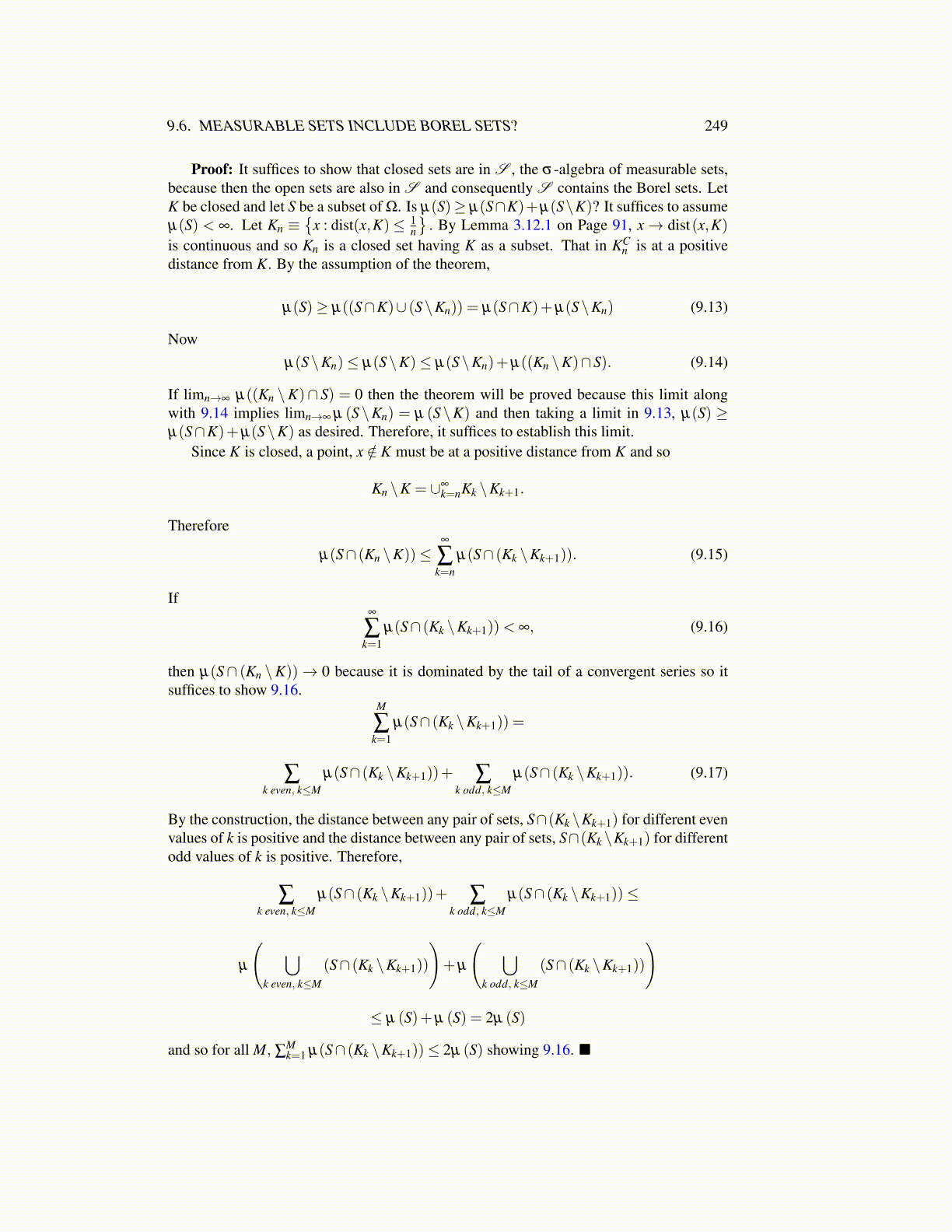
9.6. MEASURABLE SETS INCLUDE BOREL SETS? 249
Proof: It suffices to show that closed sets are in S , the σ -algebra of measurable sets,because then the open sets are also in S and consequently S contains the Borel sets. LetK be closed and let S be a subset of Ω. Is µ(S)≥ µ(S∩K)+µ(S\K)? It suffices to assumeµ(S) < ∞. Let Kn ≡
{x : dist(x,K)≤ 1
n
}. By Lemma 3.12.1 on Page 91, x→ dist(x,K)
is continuous and so Kn is a closed set having K as a subset. That in KCn is at a positive
distance from K. By the assumption of the theorem,
µ(S)≥ µ((S∩K)∪ (S\Kn)) = µ(S∩K)+µ(S\Kn) (9.13)
Nowµ(S\Kn)≤ µ(S\K)≤ µ(S\Kn)+µ((Kn \K)∩S). (9.14)
If limn→∞ µ((Kn \K)∩ S) = 0 then the theorem will be proved because this limit alongwith 9.14 implies limn→∞ µ (S\Kn) = µ (S\K) and then taking a limit in 9.13, µ(S) ≥µ(S∩K)+µ(S\K) as desired. Therefore, it suffices to establish this limit.
Since K is closed, a point, x /∈ K must be at a positive distance from K and so
Kn \K = ∪∞k=nKk \Kk+1.
Therefore
µ(S∩ (Kn \K))≤∞
∑k=n
µ(S∩ (Kk \Kk+1)). (9.15)
If∞
∑k=1
µ(S∩ (Kk \Kk+1))< ∞, (9.16)
then µ(S∩ (Kn \K))→ 0 because it is dominated by the tail of a convergent series so itsuffices to show 9.16.
M
∑k=1
µ(S∩ (Kk \Kk+1)) =
∑k even, k≤M
µ(S∩ (Kk \Kk+1))+ ∑k odd, k≤M
µ(S∩ (Kk \Kk+1)). (9.17)
By the construction, the distance between any pair of sets, S∩(Kk \Kk+1) for different evenvalues of k is positive and the distance between any pair of sets, S∩(Kk \Kk+1) for differentodd values of k is positive. Therefore,
∑k even, k≤M
µ(S∩ (Kk \Kk+1))+ ∑k odd, k≤M
µ(S∩ (Kk \Kk+1))≤
µ
( ⋃k even, k≤M
(S∩ (Kk \Kk+1))
)+µ
( ⋃k odd, k≤M
(S∩ (Kk \Kk+1))
)
≤ µ (S)+µ (S) = 2µ (S)
and so for all M, ∑Mk=1 µ(S∩ (Kk \Kk+1))≤ 2µ (S) showing 9.16. ■